HIV Therapies May Also Prevent Genetic Mutations That Cause Hemophilia, Study Finds

Researchers at South Dakota State University (SDSU) studying mouse sperm found that drugs such as those used to treat HIV infection suppress L1s, or snippets of DNA that cause gene mutations.
L1s are called transposons or mobile genetic elements. They are DNA fragments in the genome that replicate themselves and are sometimes found in the middle of genes, disrupting genetic activity.
“We know sporadic insertions can cause genetic diseases, with hemophilia being the best known examples,” Wenfeng An, who has studied L1s since 2003, told News Medical in a report on the study. An is the first endowed scholar at SDSU’s College of Pharmacy and Allied Health Professions.
One of the causes of hemophilia are L1s, which occasionally insert themselves into the gene that produces a clotting factor. That causes a mutation which disrupts the gene’s activity and prevents blood from clotting normally.
In some kinds of hemophilia, an L1 transposes itself into the clotting factor gene during sperm production. When the sperm fertilizes the mother’s egg, the resulting child inherits the mutation and develops hemophilia.
Other types of birth defects can occur the same way when an L1 is inserted in another gene in the sperm.
This study looked at gene mutations caused by L1s in sperm in mice, in which piRNA complexes were eliminated. These are naturally occurring substances which normally prevent L1s from transposing. Without them, L1 transposition increased, making it easier to study L1 activity in sperm production.
Researchers found that mice began producing sperm only seven to 14 days after birth.
“From birth to day 7, the sperm-producing factories are just waking up,” said postdoctoral research associate Simon Newkirk. In fact, by day 14 — before the mice reached sexual maturity — levels of L1-induced gene mutations were very high. Yet antiretroviral drugs, such as those used to treat HIV, prevented L1 activity in lab cell cultures.
Male mice received anti-HIV drugs before the day 7-to-14 transition period, dramatically reducing the number of L1 insertions. “We can, theoretically, decrease the number of insertions similarly in humans,” Newkirk said.






